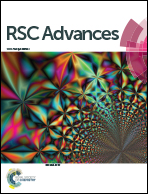Polyethylenimine mediated magnetic nanoparticles for combined intracellular imaging, siRNA delivery and anti-tumor therapy†
Abstract
Magnetic nanocarrier assisted delivery of small interfering RNA (siRNA) represents a promising approach for tumor treatment by efficiently down-regulating the expression of key tumorigenic genes, which has been proven feasible and effective for anti-tumor therapy. In the present study, polyethylenimine (PEI) mediated magnetic nanoparticles (PEI-MNPs) were synthesized as carriers for tumor treatment by combined bioimaging, siRNA delivery and in vitro therapy of glioblastoma multiforme, and their direct biological activity was elucidated in the treated tumor cells. The results demonstrated that the synthesized PEI-MNPs not only had a very low cytotoxicity in the studied concentrations, but they also showed the loading of siRNA molecules could form a stable siRNA loaded PEI-MNPs complex (siRNA–PEI-MNPs) in the tested serum. In addition, the intracellular imaging showed that the PEI-MNPs could efficiently enter the tumor cells and approach the nuclei after being uptaken, which were monitored through fluorescent magnetic labeling. The fabricated siRNA–PEI-MNPs displayed a much better therapeutic efficiency to inhibit cell proliferation, and induce cell apoptosis and autophagy of glioblastoma U251 cells, which was confirmed by analysis of the biological activity in the treated cells. Therefore, this study suggested that the fabricated PEI-MNPs are a promising non-viral nanovehicle for combined intracellular imaging and siRNA delivery for an efficient anti-tumor therapy based on a siRNA therapeutic strategy, and the siRNA–PEI-MNPs could be of great use for anti-tumor treatment in glioblastoma multiforme in the future.


 Please wait while we load your content...
Please wait while we load your content...